FRANKFURT SHOW
Page 59
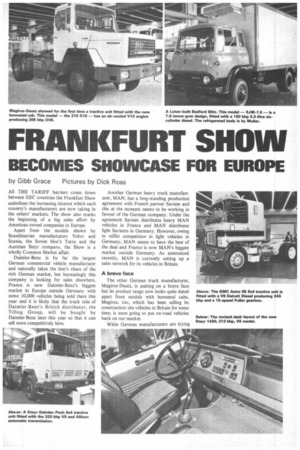
Page 60
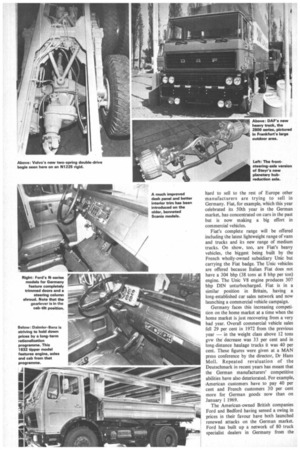
Page 61
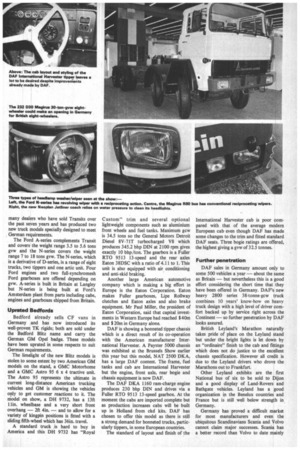
Page 62
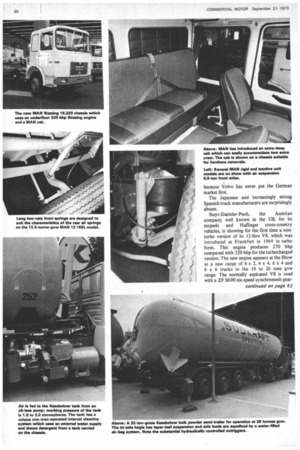
Page 65
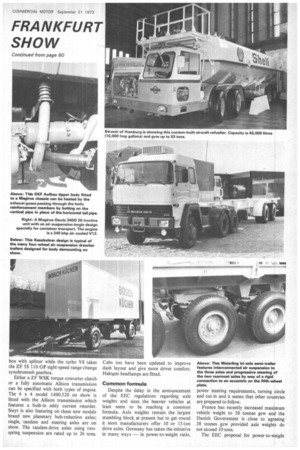
Page 66

If you've noticed an error in this article please click here to report it so we can fix it.
BECOMES SHOWCASE FOR EUROPE
by Gibb Grace Pictures by Dick Ross
AS THE TARIFF barriers come down between EEC countries the Frankfurt Show underlines the increasing interest which each country's manufacturers are now taking in the others' markets. The show also marks the beginning of a big sales effort by American-owned companies in Europe.
Apart from the models shown by Scandinavian manufacturers Volvo and Scania, the Soviet bloc's Tatra and the Austrian Steyr company, the Show is a wholly Common Market affair.
Daimler-Benz is by far the largest German commercial vehicle manufacturer and naturally takes the lion's share of the rich German market, but increasingly this company is looking for sales elsewhere. France is now Daimler-Benz's biggest market in Europe outside Germany with some 10,000 vehicles being sold there this year and it is likely that the truck side of Daimler-Benz's British distributor, the Tilling Group, will be bought by Daimler-Benz later this year so that it can sell more competitively here.
Another German heavy truck manufacturer. MAN, has a long-standing production agreement with French partner Saviem and this at the moment seems to be working in favour of the German company. Under the agreement Saviem distributes heavy MAN vehicles in France and MAN distributes light Saviems in Germany. However, owing to stiffer competition in light vehicles in Germany, MAN seems to have the best of the deal and France is now MAN's biggest market outside Germany. As announced recently, MAN is currently setting up a sales network for its vehicles in Britain.
A brave face The other German truck manufacturer, Magirus-Deutz, is putting on a brave face but its product range now looks quite dated apart from models with bonneted cabs. Magirus, too, which has been selling its construction site vehicles in Britain for some time, is soon going to put on-road vehicles back on our market.
While German manufacturers are trying hard to sell to the rest of Europe other manufacturers are trying to sell in Germany. Fiat, for example, which this year celebrated its 50th year in the German market, has concentrated on cars in the past but is now making a big effort in commercial vehicles.
Fiat's complete range will be offered including the latest lightweight range of vans and trucks and its new range of medium trucks. On show, too, are Fiat's heavy vehicles, the biggest being built by the French wholly-owned subsidiary Unic but carrying the Fiat badge. The Unic vehicles are offered because Italian Fiat does not have a 304 bhp (38 tons at 8 bhp per ton) engine. The Unic V8 engine produces 307 bhp DIN unturbocharged. Fiat is in a similar position in Britain, having a long-established car sales network and now launching a commercial vehicle campaign.
Germany faces this increasing competition on the home market at a time when the home market is just recovering from a very bad year. Overall commercial vehicle sales fell 29 per cent in 1972 from the previous year — in the weight class above 12 tons gvw the decrease was 33 per cent and in long-distance haulage trucks it was 40 per cent. These figures were given at a MAN press conference by the director, Dr Hans Moll. Repeated revaluation of the Deutschmark in recent years has meant that the German manufacturers' competitive abilities have also deteriorated. For example, -American customers have to pay 40 per cent and French customers 30 per cent more for German goods now than on January 1 1969.
The American-owned British companies Ford and Bedford having sensed a swing in prices in their favour have both launched renewed attacks on the German market. Ford has built up a network of 80 truck specialist dealers in Germany from the many dealers who have sold Transits over the past seven years and has produced two new truck models specially designed to meet German requirements.
The Ford A-series complements Transit and covers the weight range 3.5 to 5.6 tons gvw and the N-series covers the weight range 7 to 18 tons gvw. The N-series, which is a derivative of D-series, is a range of eight trucks, two tippers and one artic unit. Four Ford engines and two full-synchromesh Ford gearboxes are offered depending on gvw. A-series is built in Britain at Langley but N-series is being built at Ford's Amsterdam plant from parts including cabs, engines and gearboxes shipped from Britain.
Uprated Bectfords Bedford already sells CF vans in Germany and has now introduced its well-proven TK rigids; both are sold under the Bedford Blitz name and carry the German GM Opel badge. These models have been uprated in some respects to suit German requirements.
The limelight of the new Blitz models is stolen to some extent by two American GM models on the stand, a GMC Motorhome and a GMC Astro 95 6 x 4 tractive unit. The Astro 95 represents the ultimate in current long-distance American trucking vehicles and GM is showing the vehicles only to get customer reactions to it. The model on show, a DH 9732, has a 13ft I lin. wheelbase and a very short front overhang — 2ft 4in. — and to allow for a variety of kingpin positions is fitted with a sliding fifth-wheel which has 36in. travel.
A standard truck is hard to buy in America and this DH 9732 has "Royal
Custom– trim and several optional lightweight components such as aluminium front wheels and fuel tanks. Maximum gew is 34.5 tons so the General Motors Detroit Diesel 8V-71T turbocharged V8 which produces 345.2 bhp DIN at 2100 rpm gives exactly 10 bhp/ton. The gearbox is a Fuller RTO 9513 13-speed and the rear axles Eaton 38DSC with a ratio of 4.11 to 1. This unit is also equipped with air conditioning and anti-skid braking.
Another large American automotive company which is making a big effort in Europe is the Eaton Corporation. Eaton makes Fuller gearboxes, Lipe Rollway clutches and Eaton axles and also brake equipment. Mr Paul Miller, the president of Eaton Corporation, said that capital investments in Western Europe had reached $40m and $ 20m in Germany alone.
DAF is showing a bonneted tipper chassis which is a direct result of its co-operation with the American manufacturer International Harvester. A Payster 5000 chassis was exhibited at the Brussels Show earlier this year but this model, NAT 2500 DKA, has a large DAF content. The frame, fuel tanks and cab are International Harvester but the engine, front axle, rear bogie and chassis equipment is now DAF.
The DAF DKA 1160 ram-charge engine produces 230 bhp DIN and drives via a Fuller RTO 9513 13-speed gearbox. At the moment the cabs are imported complete but as production increases cabs will be built up in Holland from ckd kits. DAF has chosen to offer this model as there is still a strong demand for bonneted trucks, particularly tippers, in some European countries.
The standard of layout and finish of the International Harvester cab is poor compared with that of the average modern European cab even though DAF has made some changes to the trim and fitted standard DAF seats. Three bogie ratings are offered, the highest giving a gvw of 32.5 tonnes.
Further penetration DAF sales in Germany amount only to some 500 vehicles a year — about the same as Britain — but nevertheless this is a good effort considering the short time that they have been offered in Germany. DAF's new heavy 2800 series 38-tonne-gcw truck combines 10 years' know-how on heavy truck design with a high level of driver comfort backed up by service right across the Continent — so further penetration by DAF looks assured.
British Leyland's Marathon naturally takes pride of place on the Leyland stand but under the bright lights is let down by an "ordinaire" finish to the cab and fittings which does not do justice to the excellent chassis specification. However all credit is due to the Leyland drivers who drove the Marathons out to Frankfurt.
Other Leyland exhibits are the first National bus of six to be sold to Dijon and a good display of Land-Rovers and Bathgate vehicles. Leyland has a good organization in the Benelux countries and France but is still well below strength in Germany.
Germany has proved a difficult market for most manufacturers and even the ubiquitous Scandinavians Scania and Volvo cannot claim major successes. Scania has a better record than Volvo to date mainly because Volvo has never put the German market first.
The Japanese and increasingly strong Spanish truck manufacturers are surprisingly absent.
Steyr-Daimler-Puch, the Austrian company well known in the UK for its mopeds and Haflinger cross-country vehicles, is showing for the first time a nonturbo version of its 12-litre V8, which was introduced at Frankfurt in 1969 in turbo form. This engine produces 270 bhp compared with 320 bhp for the turbocharged version. The new engine appears at the Show in a new range of 4 x 2, 4 x 4. 6 x 4 and 6 x 6 trucks in the 19 to 26 tons gvw range. The normally aspirated V8 is used with a ZF S690 six-speed synchromesh gear
box with splitter while the turbo V8 takes the ZF 5S 110 GP eight-speed range-change synchromesh gearbox.
Either a ZF WSK torque converter clutch or a fully automatic Allison transmission can be specified with both types of engine. The 6 x 4 model 1490.320 on show is fitted with the Allison transmission which features a built-in eddy current retarder. Steyr is also featuring on these new models brand new planetary hub-reduction axles; single, tandem and steering axles are on show. The tandem-drive axles using twospring suspension are rated up to 26 tons. Cabs too have been updated to improve dash layout and give more driver comfort. Halogen headlamps are fitted.
Common formula Despite the delay in the announcement of the EEC regulations regarding axle weights and sizes the heavier vehicles at least seem to be reaching a common formula. Axle weights remain the largest stumbling block at present but to get round it most manufacturers offer 10 or 13-ton drive axles. Germany has taken the initiative in many ways — in power-to-weight ratio,
Above: This Meierling tri-axle semi-trailer features interconnected air suspension to the three axles and progressive steering of the two rearmost axles by way of a rigid connection to an eccentric on the fifth-wheel plate.
power steering requirements, turning circle and cut-in and it seems that other countries are prepared to follow.
France has recently increased maximum vehicle weight to 38 tonnes gew and the Danish Government is close to agreeing 38 tonnes gcw provided axle weights do not exceed 10 tons.
The EEC proposal for power-to-weight ratio is 7 bhp per ton but over the past few years nearly every major European manufacturer has developed a 304 bhp engine because from January I next year new trucks sold in Germany will require 8 bhp /ton at 38 tonnes gcw.
As yet neither German nor EEC vehicle regulations provide for the rigid eightwheeler but Magirus-Deutz, which is showing an eight-wheeler at Frankfurt, feels that it has obvious advantages as a tipper or concrete mixer chassis at 30 tons gvw. The Swiss, Magirus says, are also very interested in the eight-wheeler configuration; they would like a left-hand-drive version with 305 bhp at 28 tons gvw.
Apart from the vehicles on show there is also plenty of interest in buses, bodywork and trailers. Air suspension is widely used on vehicles and trailers as a means of demounting. Normally, trailing-arm-type suspension is used in conjunction with the rolling lobe or bellows-type of air bags.
One interesting semi-trailer on the Meirling stand has air suspension on three axles; the two rearmost axles are steered. A tubular connection runs from an eccentric on the fifth-wheel and progressively steers the axles via a lever system.
Some unusual design features are to be seen in the Striiver aircraft refueller. This four-axle chassisless design has, from front to rear, 11, 11, 18 and 13-tonne axles permitting a gvw of 53 tonnes. The third axle only is driven hydraulically from a rear transverse-mounted Deutz 413 engine. Top speed is 20 mph. The two 11-ton front axles are interconnected by a balance beam.
The Show closes on Sunday September 23.
















































































































































































